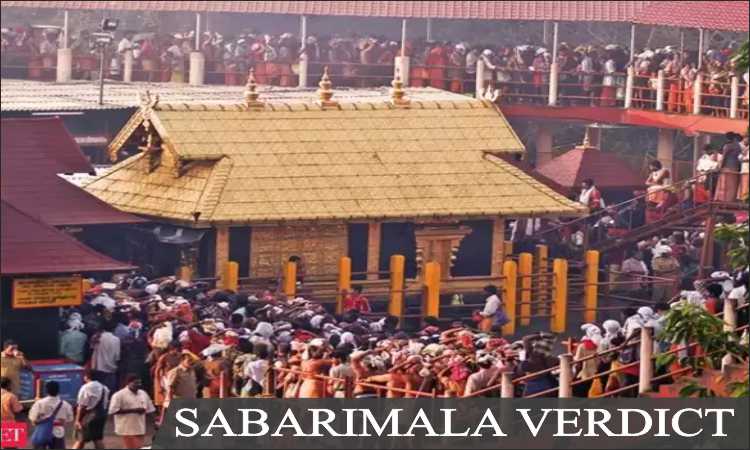Indian Young Lawyers’ Association
v.
State of Kerala
Facts & Issues -
Hon’ble supreme court on November 14 ,2019 referred the case of sabrimala temple to a seven judge constitutional bench . A constitution bench led by Chief Justice of India (CJI) Ranjan Gogoi and comprising Justices Rohinton Fali Nariman, A M Khanwilkar, D Y Chandrachud and Indu Malhotra issued the verdict in the case. Timeline of the case is as follows :
- A petition was filed was in the kerala high court in 1990 seeking the ban on the entry of a woman in the sabrimala temple and in 1991 the respective high court upheld the ban on entering of woman of age group 10-50 to the holy shrine of LORD AYAPPA.
- A PETITION WAS filed by the young lawyers associations in supreme court in2006 seeking the entry of women of age group 10-50 and after 2 years i.e, in 2008 the matter was referred to 3 judges bench .
- In 2016 the supreme court had questioned the ban on the entry of woman in the temple and later on supreme court transferred it to a constitutional bench .
- Constitutional bench of five judges headed by CJI Dipak Mishra ;with majority of4:1 delivered a judgement and removed the ban on the entry of women in sabrimala temple by strucking down the rules of Dewasom board and also stated that it is discriminatory of women’s right to equality and worship. The only dissenting opinion was given by justice Indu Malhotra who said that the court should not interfere with religious practise of sect or denomination of any religion until and unless it is harmless to anyone as like that of Sati .
Decision -
A review petition was filed and is being heard by the constitutional bench lead by the CJI JUSTICE RANJAN GOGOI and has delivered the judgement by majority of 3:2 . bench also included justice A.M. Khanwilkar , justice Indu Malhotra , justice R.F. Nariman and justice D.Y. Chandrachud .the judgement is summarised as follows:
- Given the plurarity of the religions in india it is possible that what is religious faith for one sect may not be the same for other religion ,but every one is free to profess his religion as per article 25 of indian constitution as an integral part of the religion until and unless it is against public order ,morality and part 3 of indian constitution.
- The debate about the constitutional validity of practises prevalent for rtestriction of women in religious place does not confine to this case only its stretch can also be found in muslims where women are not allowed allowed to go to durgah , female genitl mutilation in dawoodi bohra committee .court also has to look that upto which extent court can tread into the matters where it is to be determined that practise is essential to the religion or not ?
- Court also said that issues like ban on entry of woman in dargah ,female genital mutilation in dawoodi bohra community are overlapping issue and can be heard under the review petition . And court also mentions some isuues. Important ones are :
- Regarding interplay between article 25 ,26 and 14 of the indian constitution
- What is the purview of ‘public order and morality, occurring under article 25(1) and also whether is it overarching morality in reference to preamble or limited to religious belief .
- Upto what extent court can enquire into the issue whether particular practise is integral part of the religion or not.
- What is the meaning of the expression “sections of hindu “occurring in article 25(2)(b)?
- It is time that this Court should evolve a judicial policy befitting to its plenary powers to do substantial and complete justice and for an authoritative enunciation of the constitutional principles by a larger bench of not less than seven judges.
- Court should tread cautiously while dealing with religious matter under section 9 of CIVIL PROCEDURE CODE and article 32/226 of indian constitution .
- While deciding the questions delineated above, the larger bench may also consider it appropriate to decide all issues, including the question as to whether the Kerala Hindu Places of Public Worship (Authorisation of Entry) Rules, 1965 govern the temple in question all. Whether the aforesaid consideration will require grant of a fresh opportunity to all interested parties may also have to be considered.
- The subject review petitions as well as the writ petitions may, accordingly, remain pending until determination of the questions indicated above by a Larger Bench as may be constituted by the Hon’ble the Chief Justice of India.
You can also read the Blog by visiting [Blog]
For more information, visit [Aashayein Enquiry Section]
In conlusion it can be said that the court is taking a cautious step before delivering a final judgement and as the matter has been sent to constitutional bench of seven judges which shall also be the final judgement . india being the heterogenous in terms of religions ,culture the judiciary have be very sure beforte delivering any judgement and as all the matters pertaining to the subject matter of this case has also been included and also the judgements given by respective high courts in cases relating to the same issue as this case of Sabrimala shall also be taken into consideration by the bench .

